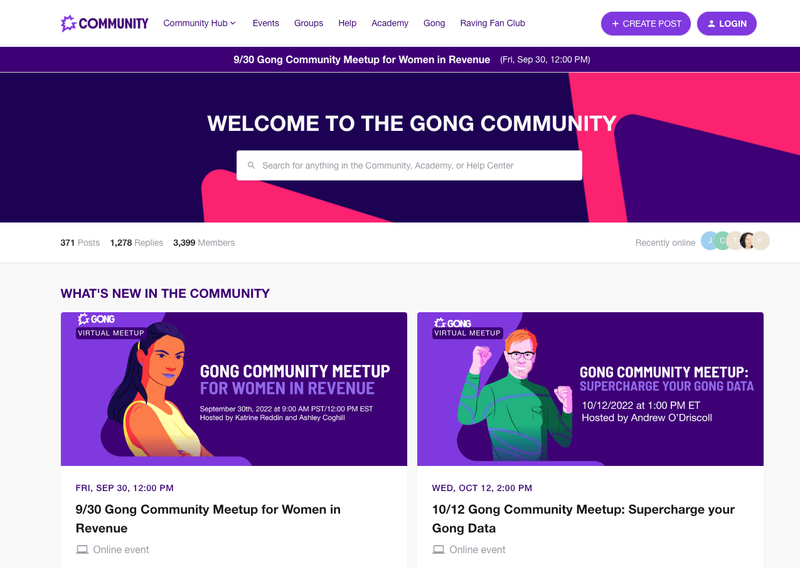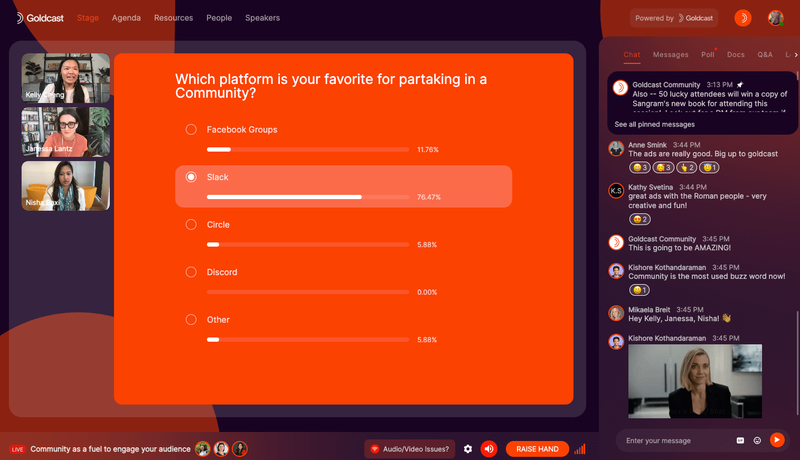Mastering B2B Communities: How Gong and dbt Labs Use Connections as Fuel for Audience Engagement

Maximize Your Marketing ROI
Join 10,000 other marketers already getting the best tips on running engaging events that boost pipeline and create raving fans.
The power of community is boundless, and B2B community-led marketing can positively impact the whole customer lifecycle.
Janessa Lantz, VP of Marketing at dbt Labs, and Nisha Baxi, Head of Community at Gong, joined Kelly Cheng, Head of Growth at Goldcast, to chat about how you can create communities and convert community members into your brand’s fanbase.
Takeaway 1. Building a community is challenging—here’s what you need to know
To begin with, the biggest thing you can do to ensure that your community survives over the years is to have a strong foundation at the company and make it a core driver.
It’s important to recognize it as a lever for the company and an important channel to have strategic alignment with the executive leadership team.
At Gong, they were lucky to have the COO believe in the power of connections and act as an internal champion for the community. What really helps that organization is its strengths in collaboration and partnership.
They have realized that if the concept of “community” gets stuck in a small support organization, then it will only ever be a support community. But if you do it right, you have the opportunity to influence so many other organizations across the company.

Janessa sees community as a distinctive element because it’s one of the few strategies that benefit from a small number of people. That’s such an important distinction.
As marketers, we like big numbers. We like long subscriber lists, lots of attendees and engagement, views, etc. But community is not about the relationship of the company to the audience. Instead, it’s about member-to-member connections.
There are huge benefits to a community being small! Being niche is not bad—it’s important to see that.
At dbt Labs, while scaling their community, they have worked to take off the “marketing hat” and put on the “community hat.” The latter needs to focus on the question of “how do we make it feel small?”
For instance, you wouldn’t want a huge group to attend an intimate office hours session. It’s actually going to be of higher quality with fewer people.
So, to be really successful with a big community, you have to keep trying to find smaller slices within that can amplify the one-on-one connections. In other words, “niche down” with your community.
You can take a page out of dbt’s playbook and experiment with specific channels around topic areas with assigned moderators.
This can be implemented for your Slack group with what are essentially micro-communities. You can also host coffee chats aligned with the individual Slack channels. Essentially, move away from the idea of a big audience.
There are huge benefits to a community being small. Being niche is not bad—it’s important to see that.”
Takeaway 2. Don’t go overboard with incentives. Members should be motivated to engage organically.
Incentives are something you have to deal with purposefully and carefully. At dbt Labs, for example, they are very intentional about not incentivizing actions.
You, too, can steer away from platforms and tools that hype up the approach of getting points for a certain kind of engagement, exchanging them for swag, etc.
The real value comes through relationships established with other people. So, if you’re creating spaces where like-minded folks can connect and learn from each other, that should be incentive enough!
It's all about getting the right people in the room. Work with that sole intent, and you are set. Remember, the content is the incentive, and it should be framed like a conversation.
Find the people that are already very excited about your category, product, etc., and meet with them. Ask them, “why do you love us?” Find out what they love about the community and why they are spending so much time in it.
As a next step, build experiences around what they find interesting and what they want more of.
At Gong, they have worked on this principle to set up an experience in the Gong community—a one-to-one matching program.
In that experience, two women who met up and became best friends mooted starting a “women in revenue” meetup. This ties back to the idea of a smaller community within a larger community.
It’s key to note that this kicked off on the heels of a user-generated idea. It’s not about the product but about Gong being the enabler of people who are driven and passionate so they can also connect on other things that are important to them.
Another thing you can do to swing organic engagement is to pick up on people’s motivation by “notoriety.” A community can offer notoriety by promoting one’s standout content creation. You can pin it, egg on others to check it out—basically, find different ways to celebrate members.
The real value comes through relationships established with other people. So, if you’re creating spaces where like-minded folks can connect and learn from each other, that should be incentive enough.”
Takeaway 3. Communities have tangible benefits outside of just awareness
According to Janessa, community is about awareness and brand and category creation, but it can be useful in a supporting role, too, closer to the product. At dbt Labs, they are much more mature on the ToFu, and the BoFu has been an afterthought.
For them, the primary focus is on how the community is creating awareness.
When you talk about BoFu marketing activities, you have to have attribution, even if it’s flawed. For awareness by brand affinity channels, attribution is not that good — it’s limited to stuff you can see, like as clicks and web activity.
For this reason, Janessa is a big fan of common sense attribution — simply having a question on the sales form. For dbt Labs, the #1 bucket is always word of mouth or the community. There is not an insignificant number of people that just attribute community directly.
As they see it, community is the engine that drives other activities.
From Nisha’s perspective, there are two ways to measure success and two different metrics: What are the top-line business goals, and what impact can you make with the community?
Apart from NDR influence and ARR, there are community health metrics to consider — are people registering? Are they active?
Nisha ascribes to the SPACES model for how she thinks about the community and how it impacts the business.
Takeaway 4. Companies need a strong point of view and clear objectives before they launch a community
As Nisha puts it, you have to have a strong “why” before you start a community. If you don’t already have a core group of people, it won’t flourish or grow.
See if there are communities that already exist with the type of persona that you're going for and create smaller communities within that. That could be more impactful for the company in the long run.
At the core of it, getting a community off the ground is all about getting a group of people together that care about a specific cause. Maybe it’s a new category, a new profession, or a new niche area.
So, having the core group is key to the community flourishing. Also, follow the music—it’s not about what you want as a company. Instead, it’s about what the people want and enabling that to come about.

According to Janessa, another thing that makes for a solid kick-off on communities is dissolving the intense focus on the question of “What platform do we build the community on?”
Ultimately, what you are doing and your community will never be defined by a platform.
Remember, people are talking about your brand already. It’s just a question of making it easy for them to find other people who are doing the same.
It’s also key to recognize that having a community means you could have thousands of people showing up to tell you you're wrong about something. At the end of the day, there are all kinds of expectations riding on your brand.
So, getting serious about building a community means rethinking your relationship with your customers and the audience and knowing how to navigate choppy situations.
Another thing that Janessa emphasized is not placing a pronoun like “our” with a community. You’ll be well-served by being a stickler for calling it “the” community. Seeing that one can’t stake a claim on a community or own it in any sense—this is a crucial mind-shift, particularly for marketers.
To sum up, in launching a community, think less about the platform, and spend more time thinking about what you want your relationship with your customers to be. Most importantly, figure out how you can create value for them by helping them find each other.

Transform Your Video Marketing with AI
Stay In Touch
Platform
Resources
© 2025 Copyright Goldcast, Inc. All rights reserved.





 Upcoming Events
Upcoming Events Event Series
Event Series On-Demand Events
On-Demand Events

